Animal Kingdom MCQ Solved Paper for CAT
Thursday 9th of March 2023

Sharing is caring
1. Meandrina (brain coral) belongs to phylum
A. porifera
B. coelenterata
C. ctenophora
D. platyhelminthes
Answer : B
A. porifera
B. coelenterata
C. ctenophora
D. platyhelminthes
Answer : B
2. Identify the figures and select the correct option
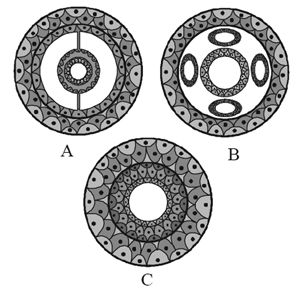
A. A - Pseudocoelomate; B - Coelomate, C-Acoelomate
B. A - Coelomate, B - Pseudocoelomate, C- Acoelomate
C. A - Coelomate; B- Acoelomate; C - Pseudocoelomate
D. A - Coelomate; B- Acoelomate; C-Eucoelomate
Answer : B

A. A - Pseudocoelomate; B - Coelomate, C-Acoelomate
B. A - Coelomate, B - Pseudocoelomate, C- Acoelomate
C. A - Coelomate; B- Acoelomate; C - Pseudocoelomate
D. A - Coelomate; B- Acoelomate; C-Eucoelomate
Answer : B
3. Hemichordates have now been placed with the nonchordates, close to echinoderms, because true
A. notochord is absent.
B. pharyngeal gill-slits are lacking.
C. dorsal nerve cord is absent.
D. heart is lacking.
Answer : A
A. notochord is absent.
B. pharyngeal gill-slits are lacking.
C. dorsal nerve cord is absent.
D. heart is lacking.
Answer : A
4. Match the phylum given in column - I with the special features present in them given in column - II and choose the correct option.
A. A III; B IV; C V; D II; E I
B. A IV; B III; C V; D II; E I
C. A III; B IV; C II; D V; E I
D. A III; B V; C IV; D II; E I
Answer : A
| Column -I | Column- II |
|---|---|
| (Phylum) | (Special features present) |
| A. Porifera | I. Mammary glands |
| B. Mollusca | II. Cloaca |
| C. Ctenophora | III. Choanocytes |
| D. Amphibia | IV. Radula |
| E. Mammalia | V. Comb plates |
A. A III; B IV; C V; D II; E I
B. A IV; B III; C V; D II; E I
C. A III; B IV; C II; D V; E I
D. A III; B V; C IV; D II; E I
Answer : A
5. Which of the following belong to phylum arthropoda?
A. Bombyx and Apis
B. Laccifer and Anopheles
C. Locusta and Limulus
D. All of the above
Answer : D
A. Bombyx and Apis
B. Laccifer and Anopheles
C. Locusta and Limulus
D. All of the above
Answer : D
6. Which of the following class is being described by the given statements (i - iv)?
(i) They are found in a variety of habitats- polar ice-caps, deserts, mountains, forests, grasslands and dark caves.
(ii) Most unique mammalian characteristic is the presence of mammary glands by which the young ones are nourished.
(iii) Heart is four-chambered.
(iv) Sexes are separate and fertilization is internal.
A. Reptilia
B. Aves
C. Mammalia
D. Amphibia
Answer : C
(i) They are found in a variety of habitats- polar ice-caps, deserts, mountains, forests, grasslands and dark caves.
(ii) Most unique mammalian characteristic is the presence of mammary glands by which the young ones are nourished.
(iii) Heart is four-chambered.
(iv) Sexes are separate and fertilization is internal.
A. Reptilia
B. Aves
C. Mammalia
D. Amphibia
Answer : C
7. Match the characteristic feature/terms given in column I with the phylum to which they belongs given in column II and choose the correct option.
A. A II; B I; C IV; D V; E III
B. A II; B IV; C I; D V; E III
C. A V; B I; C III; D II; E IV
D. A III; B IV; C I; D V; E II
Answer : D
| Column-I | Column-II |
|---|---|
| (Characteristic feature/term) | (Phylum) |
| A. Choanocytes | I. Platyhelminthes |
| B. Cnidoblasts | II. Ctenophora |
| C. Flame cells | III. Porifera |
| D. Nephridia | IV. Coelenterata |
| E. Comb plates | V. Annelida |
A. A II; B I; C IV; D V; E III
B. A II; B IV; C I; D V; E III
C. A V; B I; C III; D II; E IV
D. A III; B IV; C I; D V; E II
Answer : D
8. Which of the following animal contains respiratory organs like, gills, book gills, book lungs or tracheal system?
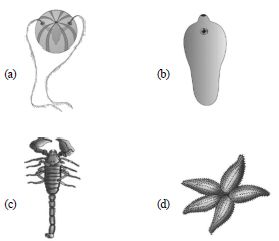
A. Click to check answer
B. Click to check answer
C. Click to check answer
D. Click to check answer
Answer : C

A. Click to check answer
B. Click to check answer
C. Click to check answer
D. Click to check answer
Answer : C
9. Refer the given figures A, B, C and D and identify the option which shows their correct name.
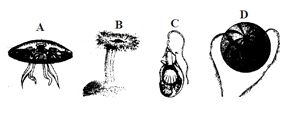
A. A - Pleurobrachia, B - Cnidoblast, C - Aurelia, D - Adamsia
B. A - Aurelia, B - Adamsia, C - Cnidoblast, D - Pleurobrachia
C. A - Cnidoblast, B - Pleurobrachia, C - Adamsia, D - Aurelia
D. A - Adamsia, B - Aurelia, C - Pleurobrachia, D - Cnidoblast
Answer : B

A. A - Pleurobrachia, B - Cnidoblast, C - Aurelia, D - Adamsia
B. A - Aurelia, B - Adamsia, C - Cnidoblast, D - Pleurobrachia
C. A - Cnidoblast, B - Pleurobrachia, C - Adamsia, D - Aurelia
D. A - Adamsia, B - Aurelia, C - Pleurobrachia, D - Cnidoblast
Answer : B
10. Which of the following characteristic is probably most responsible for the great diversification of insects on land ?
A. Segmentation
B. Antennae
C. Bilateral symmetry
D. Exoskeleton
Answer : D
A. Segmentation
B. Antennae
C. Bilateral symmetry
D. Exoskeleton
Answer : D
11. Select the incorrect feature of mollusca from the given statements.
A. (i) and (ii) only
B. (ii) and (iv) only
C. (i), (ii) and (iv) only
D. All the five statements.
Answer : C
- Terrestrial or aquatic animals having cellular system level of organization.
- Radial symmetrical and acoelomate animals and possesses two germinal layers.
- A file like rasping organ called radula is present.
- Usually dioecious and viviparous animals.
- Examples include Pila, Octopus, and Dentalium.
A. (i) and (ii) only
B. (ii) and (iv) only
C. (i), (ii) and (iv) only
D. All the five statements.
Answer : C
12. Which of the following is not the common fundamental feature for animal classification?
A. Germinal layers.
B. Pathway of water transport.
C. Pattern of organization of cells.
D. Serial repetition of the segments.
Answer : B
A. Germinal layers.
B. Pathway of water transport.
C. Pattern of organization of cells.
D. Serial repetition of the segments.
Answer : B
13. In amphibians, heart is ________ chambered.
A. two
B. three
C. four
D. none of these
Answer : B
A. two
B. three
C. four
D. none of these
Answer : B
14. Match the features given in column I with their examples given in column II and choose the correct match from the option given below.
A. A - e, B - b, C - d, D - c, E - a
B. A - c, B - a, C - d, D - b, E - e
C. A - b, B - a, C - c, D - e, E - d
D. A - c, B - b, C - d, D - a, E - e
Answer : B
| Column-I | Column-II |
|---|---|
| (Features) | (Examples) |
| A. Pseudocoelomates | a. Hydra, Adamsia |
| B. Diploblastic | b. Ctenoplana, Aurelia |
| C. Cellular level of | c. Ascaris, Wuchereria organization |
| D. Radial symmetry | d. Sycon, Spongilla |
| E. Metamerism | e. Pheretima, Neries |
A. A - e, B - b, C - d, D - c, E - a
B. A - c, B - a, C - d, D - b, E - e
C. A - b, B - a, C - c, D - e, E - d
D. A - c, B - b, C - d, D - a, E - e
Answer : B
15. Identify the animals shown in the given figures A, B and C from options given below.

A. A - Octopus; B -Asterias, C- Ophiura
B. A - Asterias; B - Ophiura, C- Octopus
C. A - Echinus; B - Octopus C - Ophiura
D. A - Ophiura; B - Echinus, C- Octopus
Answer : A

A. A - Octopus; B -Asterias, C- Ophiura
B. A - Asterias; B - Ophiura, C- Octopus
C. A - Echinus; B - Octopus C - Ophiura
D. A - Ophiura; B - Echinus, C- Octopus
Answer : A
16. In phylum arthropoda, excretion takes place through
A. nephridia
B. flame cells
C. malphigian tubules
D. gills
Answer : C
A. nephridia
B. flame cells
C. malphigian tubules
D. gills
Answer : C
17. Heart is three - chambered in reptiles, except
A. turtle
B. Chameleon
C. Naja (Cobra)
D. crocodile
Answer : D
A. turtle
B. Chameleon
C. Naja (Cobra)
D. crocodile
Answer : D
18. Refer the following statement and answer the question. 'Name of X is derived from stinging capsules. It exhibits metagenesis containing two body forms in which sessile and cylindrical form is called Y and umbrella shaped and free swimming is called Z. Identify X, Y, and Z.
A. X - Coelenterate, Y - Polyp, Z - Medusa
B. X - Cnidarian, Y - Medusa, Z - Polyp
C. X - Ctenophora, Y - Radula, Z - Hypostome
D. X - Porifera, Y - Osculum, Z - Radula
Answer : A
A. X - Coelenterate, Y - Polyp, Z - Medusa
B. X - Cnidarian, Y - Medusa, Z - Polyp
C. X - Ctenophora, Y - Radula, Z - Hypostome
D. X - Porifera, Y - Osculum, Z - Radula
Answer : A
19. Which of the following pairs of animals are similar to each other pertaining to the feature stated against them?
A. Pteropus and Ornithorhyncus - Viviparity
B. Garden lizard and crocodile - Three chambered heart
C. Ascaris and Ancylostoma - Metameric segmentation
D. Sea horse and flying fish - Cold blooded (poikilothermal)
Answer : D
A. Pteropus and Ornithorhyncus - Viviparity
B. Garden lizard and crocodile - Three chambered heart
C. Ascaris and Ancylostoma - Metameric segmentation
D. Sea horse and flying fish - Cold blooded (poikilothermal)
Answer : D
20. Read the following statements and answer the question.
(i) They are exclusively marine, radially symmetrical, diploblastic organisms with tissue level of organisation.
(ii) Body bears eight external rows of ciliated comb plates, which help in locomotion.
(iii) Digestion is both extracellular and intracellular.
(iv) Reproduction takes place only by sexual means.
Which of the following phylum is being described by above statements?
A. Platyhelminthes
B. Arthropoda
C. Mollusca
D. Ctenophora
Answer : D
(i) They are exclusively marine, radially symmetrical, diploblastic organisms with tissue level of organisation.
(ii) Body bears eight external rows of ciliated comb plates, which help in locomotion.
(iii) Digestion is both extracellular and intracellular.
(iv) Reproduction takes place only by sexual means.
Which of the following phylum is being described by above statements?
A. Platyhelminthes
B. Arthropoda
C. Mollusca
D. Ctenophora
Answer : D
21. Which one of the following groups of animals is correctly matched with its characteristic feature without even a single exception ?
A. Reptilia : possess 3 - chambered heart with one incompletely divided ventricle.
B. Chordata : Possess a mouth provided with an upper and lower jaw.
C. Chondrichthyes : Possess cartilaginous endoskeleton.
D. Mammalia : Give birth to young one.
Answer : C
A. Reptilia : possess 3 - chambered heart with one incompletely divided ventricle.
B. Chordata : Possess a mouth provided with an upper and lower jaw.
C. Chondrichthyes : Possess cartilaginous endoskeleton.
D. Mammalia : Give birth to young one.
Answer : C
22. Which of the following is not a characteristic feature of kingdom animalia ?
A. Storage of carbohydrates as starch.
B. Multicellularity.
C. Obtaining nutrients by ingestion.
D. Having eukaryotic cells without walls.
Answer : A
A. Storage of carbohydrates as starch.
B. Multicellularity.
C. Obtaining nutrients by ingestion.
D. Having eukaryotic cells without walls.
Answer : A
23. In phylum echinodermata, the adult echinoderms are ______A__________ but larvae are _______B______ .
A. A radially symmetrical; B bilaterally symmetrical
B. A bilaterally symmetrical; B radially symmetrical
C. A bilaterally symmetrical; B asymmetrical
D. A metamerically segmented; B asymmetrical
Answer : A
A. A radially symmetrical; B bilaterally symmetrical
B. A bilaterally symmetrical; B radially symmetrical
C. A bilaterally symmetrical; B asymmetrical
D. A metamerically segmented; B asymmetrical
Answer : A
24. Which of the following pairs of animals comprises jawless fishes?
A. Mackerals and rohu
B. Lampreys and hag fishes
C. Guppies and hag fishes
D. Lampreys and eels
Answer : B
A. Mackerals and rohu
B. Lampreys and hag fishes
C. Guppies and hag fishes
D. Lampreys and eels
Answer : B
25. Which of the following characteristics is correct for reptilia?
A. Body covered with dry and cornified skin, scales over the body are epidermal, they do not have external ears.
B. Body is covered with moist skin and is devoid of scales, the ear is represented by a tympanum, alimentary canal, urinary and reproductive tracts open into a common cloaca.
C. Fresh water animals with bony endoskeleton and airbladder regulate buoyancy.
D. Marine animals with cartilaginous endoskeleton and body is covered with placoid scales.
Answer : A
A. Body covered with dry and cornified skin, scales over the body are epidermal, they do not have external ears.
B. Body is covered with moist skin and is devoid of scales, the ear is represented by a tympanum, alimentary canal, urinary and reproductive tracts open into a common cloaca.
C. Fresh water animals with bony endoskeleton and airbladder regulate buoyancy.
D. Marine animals with cartilaginous endoskeleton and body is covered with placoid scales.
Answer : A
26. Which of the following statement(s) is/are correct regarding phylum mollusca?
A. They are bilaterally symmetrical, triploblastic and coelomate animals.
B. Body is covered by a calcareous shell and is unsegmented with a distinct head, muscular foot and visceral hump.
C. The mouth contains a file-like rasping organ for feeding, called radula.
D. All of the above
Answer : D
A. They are bilaterally symmetrical, triploblastic and coelomate animals.
B. Body is covered by a calcareous shell and is unsegmented with a distinct head, muscular foot and visceral hump.
C. The mouth contains a file-like rasping organ for feeding, called radula.
D. All of the above
Answer : D
27. Which of the following statement(s) is/are correct?
(i) Animals in which the cells are arranged in two embryonic layers, an external ectoderm and an internal endoderm, are called diploblastic animals.
(ii) Notochord is an ectodermally derived rod like structure formed on the ventral side during embryonic development in some animals.
(iii) In some animals, the body cavity is not lined by mesoderm, instead, the mesoderm is present as scattered pouches in between the ectoderm and endoderm and such a body cavity is called pseudocoelom.
A. Only (i)
B. Both (i) and (ii)
C. Both (i) and (iii)
D. All of these
Answer : C
(i) Animals in which the cells are arranged in two embryonic layers, an external ectoderm and an internal endoderm, are called diploblastic animals.
(ii) Notochord is an ectodermally derived rod like structure formed on the ventral side during embryonic development in some animals.
(iii) In some animals, the body cavity is not lined by mesoderm, instead, the mesoderm is present as scattered pouches in between the ectoderm and endoderm and such a body cavity is called pseudocoelom.
A. Only (i)
B. Both (i) and (ii)
C. Both (i) and (iii)
D. All of these
Answer : C
28. Examine the figures A, B and C. In which one of the four options all the items A, B and C are correctly identified ?

A. A - Sycon, B - Euspongia, C - Spongilla
B. A - Euspongia, B - Spongilla, C - Sycon
C. A - Spongilla, B - Sycon, C - Euspongia
D. A - Euspongia, B - Sycon, C - Spongilla
Answer : A

A. A - Sycon, B - Euspongia, C - Spongilla
B. A - Euspongia, B - Spongilla, C - Sycon
C. A - Spongilla, B - Sycon, C - Euspongia
D. A - Euspongia, B - Sycon, C - Spongilla
Answer : A
29. Match the types of animals given in column I with their examples given in column II and choose the correct option.
A. A II; B V; C IV; D I; E III
B. A V; B II; C IV; D I; E III
C. A V; B II; C I; D IV; E III
D. A V; B IV; C II; D I; E III
Answer : B
| Column -I | Column -II |
|---|---|
| (Types of animals) | (Examples) |
| A. Limbless reptiles | I. Elephant |
| B. Jawless vertebrates | II. Lamprey |
| C. Flightless bird | III. Ichthyophis |
| D. Largest | IV. Ostrich terrestrial animal |
| E. Limbless amphibia | V. Cobra |
A. A II; B V; C IV; D I; E III
C. A V; B II; C I; D IV; E III
D. A V; B IV; C II; D I; E III
Answer : B
30. Tracheae of cockroach and mammal are similar in having
A. paired nature.
B. non-collapsible walls.
C. ciliated inner lining.
D. origin from head.
Answer : B
A. paired nature.
B. non-collapsible walls.
C. ciliated inner lining.
D. origin from head.
Answer : B
31. The figure given below shows the germinal layers marked as A, B, C and D. Identify the label showing undifferentiated layer and its location?
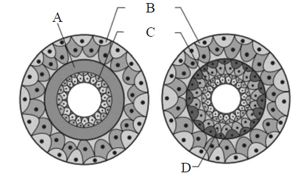
A. A, Between B & C
B. B, Between A & C
C. C, Between C & D
D. D, Between A & B
Answer : A

A. A, Between B & C
B. B, Between A & C
C. C, Between C & D
D. D, Between A & B
Answer : A
32. The combination of a true coelom and repeating body segmentation allows the annelids (unlike the anatomically simpler worms) to do which of the following?
A. Attain complex body shapes and thus locomote more precisely.
B. Move through loose marine sediments.
C. Be hermaphroditic.
D. Inject paralytic poisons into their prey.
Answer : A
A. Attain complex body shapes and thus locomote more precisely.
B. Move through loose marine sediments.
C. Be hermaphroditic.
D. Inject paralytic poisons into their prey.
Answer : A
33. Which of the following is not a chordate character?
A. Presence of paired pharyngeal gill slits
B. Ventral heart
C. Solid and ventral nerve cord
D. Presence of post-anal tail
Answer : C
A. Presence of paired pharyngeal gill slits
B. Ventral heart
C. Solid and ventral nerve cord
D. Presence of post-anal tail
Answer : C
34. Identify the figure with its correct name and phylum.
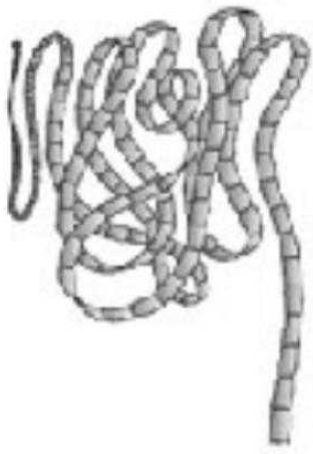
A. Sycon - Porifera
B. Aurelia - Coelenterata
C. Pleurobrachia - Ctenophora
D. Tapeworm - Platyhelminthes
Answer : D

A. Sycon - Porifera
B. Aurelia - Coelenterata
C. Pleurobrachia - Ctenophora
D. Tapeworm - Platyhelminthes
Answer : D
35. Which of the following feature in birds indicates their reptilian ancestory ?
A. Eggs with a calcareous shell
B. Scales on their hind limbs
C. Four-chambered heart
D. Two special chambers-crop and gizzard in their digestive tract
Answer : C
A. Eggs with a calcareous shell
B. Scales on their hind limbs
C. Four-chambered heart
D. Two special chambers-crop and gizzard in their digestive tract
Answer : C
36. Which of the following is a connecting link between invertebrates and non-invertebrates?
A. Sphenodon
B. Balanoglossus
C. Tadpole larva
D. Crocodile
Answer : B
A. Sphenodon
B. Balanoglossus
C. Tadpole larva
D. Crocodile
Answer : B
37. Polyp phase is absent in
A. Hydra
B. Aurelia
C. Physalia
D. Obelia
Answer : B
A. Hydra
B. Aurelia
C. Physalia
D. Obelia
Answer : B
38. The following statement are associated with the occurrence of notochord. Identify the incorrect statement.
A. It is present only in larval tail in ascidians.
B. It is replaced by a vertebral column in adult frog.
C. It is absent throughout the life in humans from the very beginning.
D. It is present throughout life in Amphioxus.
Answer : C
A. It is present only in larval tail in ascidians.
B. It is replaced by a vertebral column in adult frog.
C. It is absent throughout the life in humans from the very beginning.
D. It is present throughout life in Amphioxus.
Answer : C
39. Which of the following is a living fossil?
A. Balanoglossus
B. Echinus
C. Ancylostoma
D. Limulus
Answer : D
A. Balanoglossus
B. Echinus
C. Ancylostoma
D. Limulus
Answer : D
40. Which of the following group of animals reproduces only by sexual means?
A. Ctenophora
B. Cnidaria
C. Porifera
D. Protozoa
Answer : A
A. Ctenophora
B. Cnidaria
C. Porifera
D. Protozoa
Answer : A
41. Which of the following possesses poison sting and belongs to class chondrichthyes?
A. Labeo
B. Myxine
C. Clarias
D. Trygon
Answer : D
A. Labeo
B. Myxine
C. Clarias
D. Trygon
Answer : D
42. Few cnidarians like corals have a skeleton composed of
A. calcium hydroxide
B. calcium sulphate
C. calcium carbonate
D. sodium bicarbonate
Answer : C
A. calcium hydroxide
B. calcium sulphate
C. calcium carbonate
D. sodium bicarbonate
Answer : C
43. Aquatic annelids (like Nereis) possess lateral appendages called ______________, which help in swimming.
A. visceral hump
B. parapodia
C. radula
D. spicules
Answer : B
A. visceral hump
B. parapodia
C. radula
D. spicules
Answer : B
44. The given figures A, B, C and D are the examples of first true land vertebrates. They are dominant in mesozoic era and belong to phylum ‘X’. Identify ‘X’ and the animals which have four chambered heart.
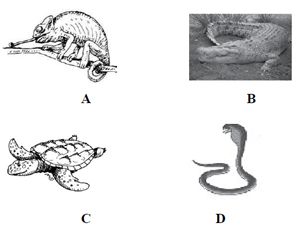
A. X – Reptile; B
B. X – Reptile; A
C. X – Amphibia, C
D. X – Pisces; D
Answer : A

A. X – Reptile; B
B. X – Reptile; A
C. X – Amphibia, C
D. X – Pisces; D
Answer : A
45. In amphibians, respiration occurs through
A. gills
B. lungs
C. skin
D. all of these
Answer : D
A. gills
B. lungs
C. skin
D. all of these
Answer : D
46. Flame cells present in platyhelminthes, are specialized in
A. respiration and absorption.
B. osmoregulation and circulation.
C. respiration and excretion.
D. osmoregulation and excretion.
Answer : D
A. respiration and absorption.
B. osmoregulation and circulation.
C. respiration and excretion.
D. osmoregulation and excretion.
Answer : D
47. Which of the follwoing statement(s) is/are correct?
(i) Organ systems in different group of animals show various patterns of complexities.
(ii) The digestive system in platyhelminthes has only a single opening to the outside of the body that serve as both mouth and anus, and is hence called complete.
(iii) In open type of circulatory system, the blood is pumped out of the heart and the cells and tissues are directly bathed in it.
(iv) In closed type, the blood is circulated through a series of vessels of varying diameters (arteries, veins and capillaries).
A. Only (i)
B. Both (ii) and (iii)
C. (i), (iii) and (iv)
D. All of these
Answer : C
(i) Organ systems in different group of animals show various patterns of complexities.
(ii) The digestive system in platyhelminthes has only a single opening to the outside of the body that serve as both mouth and anus, and is hence called complete.
(iii) In open type of circulatory system, the blood is pumped out of the heart and the cells and tissues are directly bathed in it.
(iv) In closed type, the blood is circulated through a series of vessels of varying diameters (arteries, veins and capillaries).
A. Only (i)
B. Both (ii) and (iii)
C. (i), (iii) and (iv)
D. All of these
Answer : C
48. Refer the following animals and identify those which have a fluid filled body cavity with a complete lining derived from mesoderm.
(i) Sycon (ii) Butterfly
(iii) Nereis (iv) Sea fan
(v) Scorpion (vi) Pila
A. (i) and (iii) only
B. (ii) and (iv) only
C. (ii), (iii), (v) and (vi) only
D. All of these
Answer : C
(i) Sycon (ii) Butterfly
(iii) Nereis (iv) Sea fan
(v) Scorpion (vi) Pila
A. (i) and (iii) only
B. (ii) and (iv) only
C. (ii), (iii), (v) and (vi) only
D. All of these
Answer : C
49. Which of the following features distinguish mammals from other vertebrates ?
A. Hairy skin and oviparity
B. Hairy skin and mammary glands
C. Mammary glands and teeth
D. Pinna and teeth
Answer : B
A. Hairy skin and oviparity
B. Hairy skin and mammary glands
C. Mammary glands and teeth
D. Pinna and teeth
Answer : B
50. Which of the following statements (i v) are incorrect?
(i) Parapodia are lateral appendages in arthropods used for swimming.
(ii) Radula in molluscs are structures involved in excretion.
(iii) Aschelminthes are dioecious.
(iv) Echinoderm adults show radial symmetry.
(v) Ctenophorans are diploblastic.
A. (i) and (ii)
B. (i) and (iii)
C. (i), (iv) and (v)
D. (iii) and (v)
Answer : A
(i) Parapodia are lateral appendages in arthropods used for swimming.
(ii) Radula in molluscs are structures involved in excretion.
(iii) Aschelminthes are dioecious.
(iv) Echinoderm adults show radial symmetry.
(v) Ctenophorans are diploblastic.
A. (i) and (ii)
B. (i) and (iii)
C. (i), (iv) and (v)
D. (iii) and (v)
Answer : A
Sharing is caring
Related Post
RBI Assistant - Electrical Circuits 1000+ MCQ [Solved] PDF Download
IBPS Common Written Exam (PO/MT) Main 2016 Solved Paper 1000+ MCQ with answer for ISRO Recruitment
SSC Scientific Assistant - Building Materials 1000+ MCQ [Solved] PDF Download
1000+ Planet Kingdom Multiple Choice Question Answer [Solved]
Phylum - Coelentrata MCQ Solved Paper for SBI PO
Airport Engineering MCQ Solved Paper for SSC Scientific Assistant